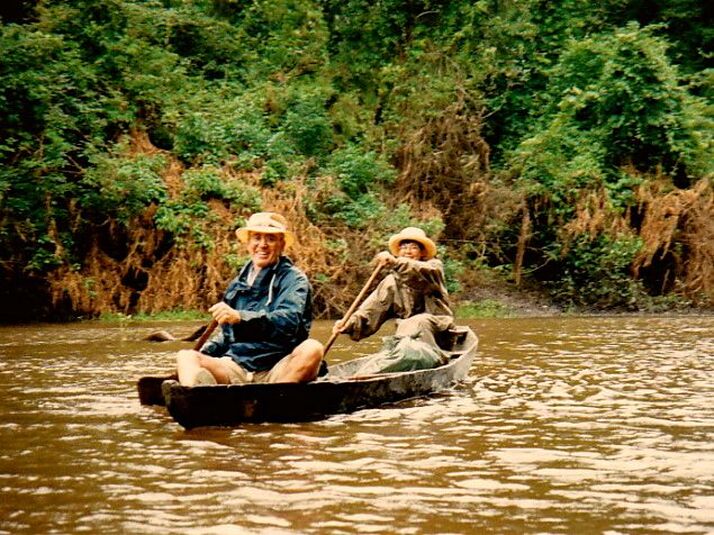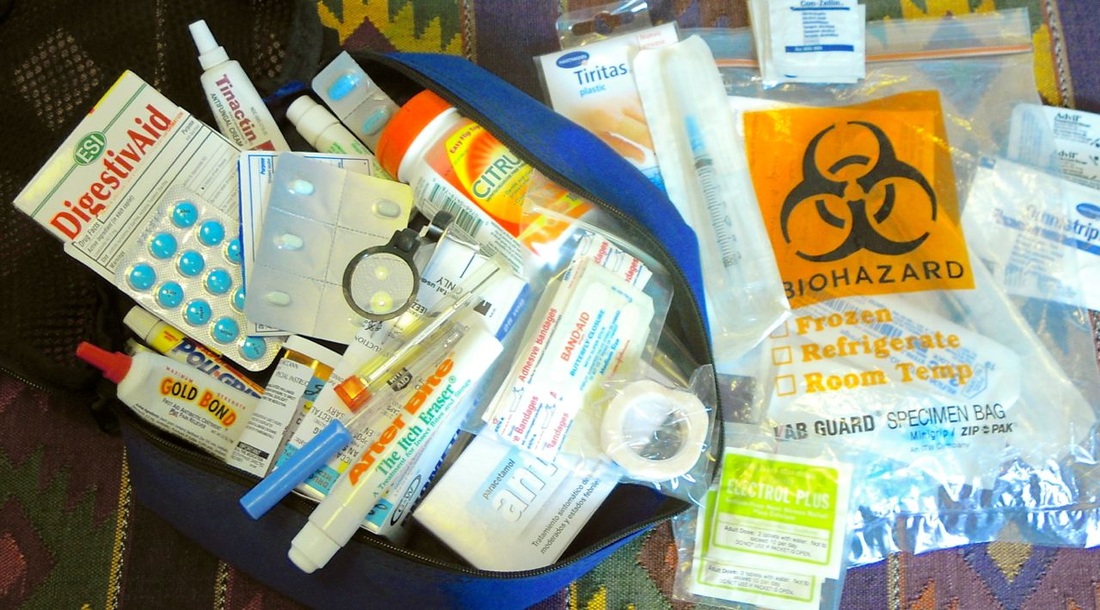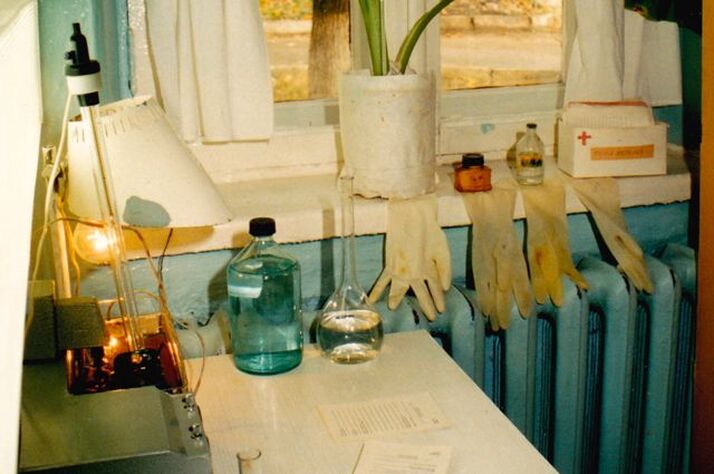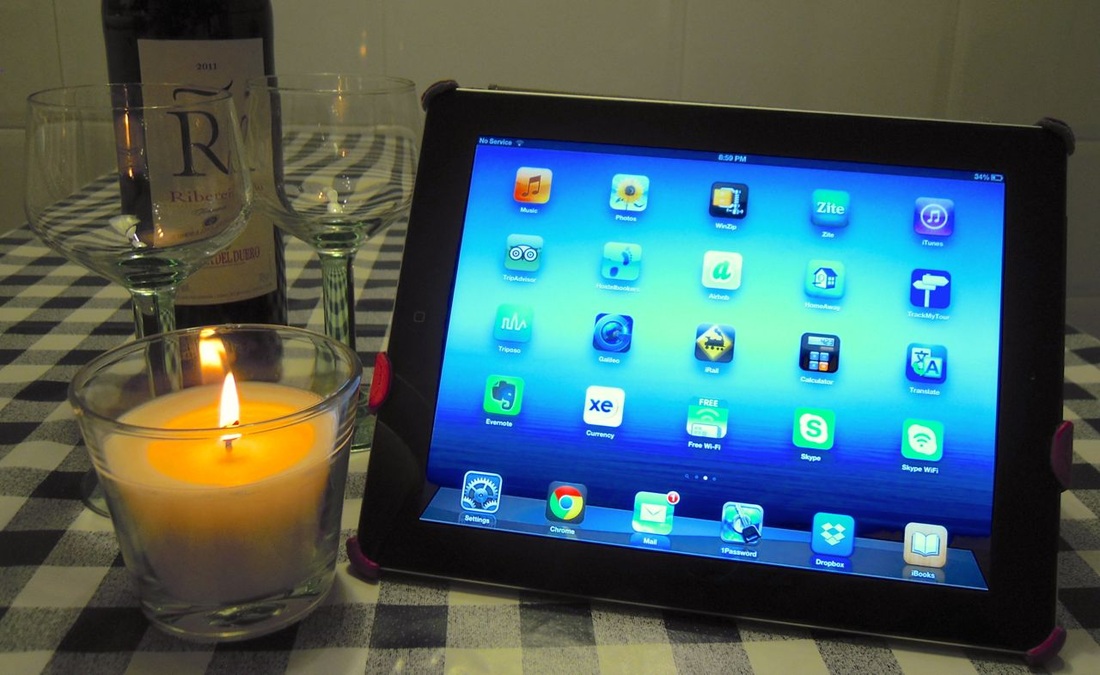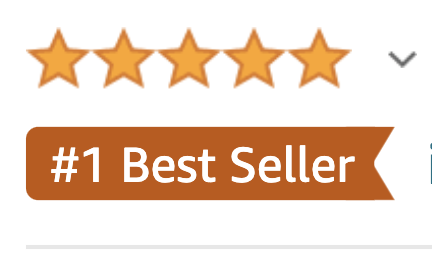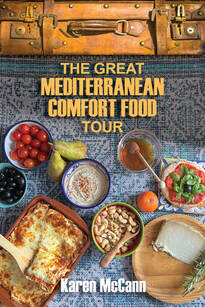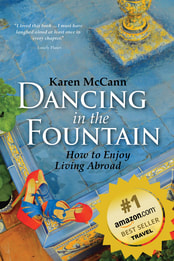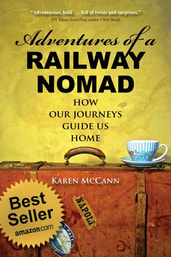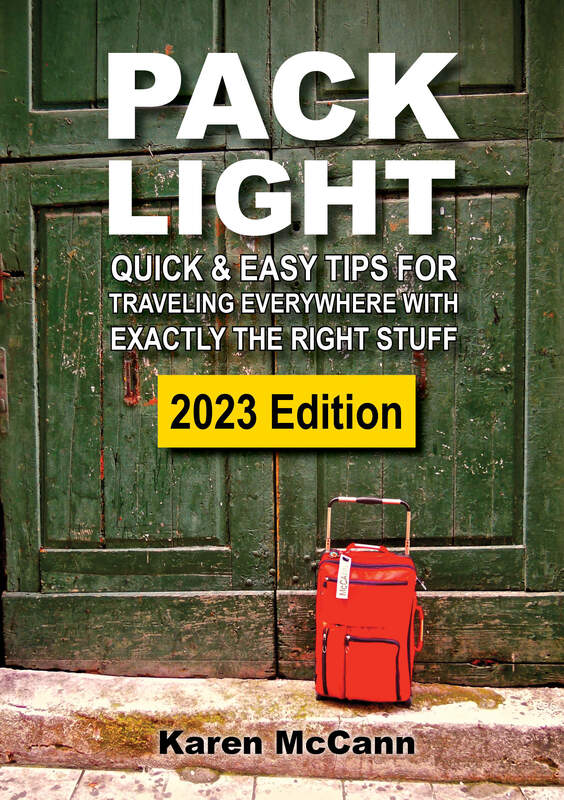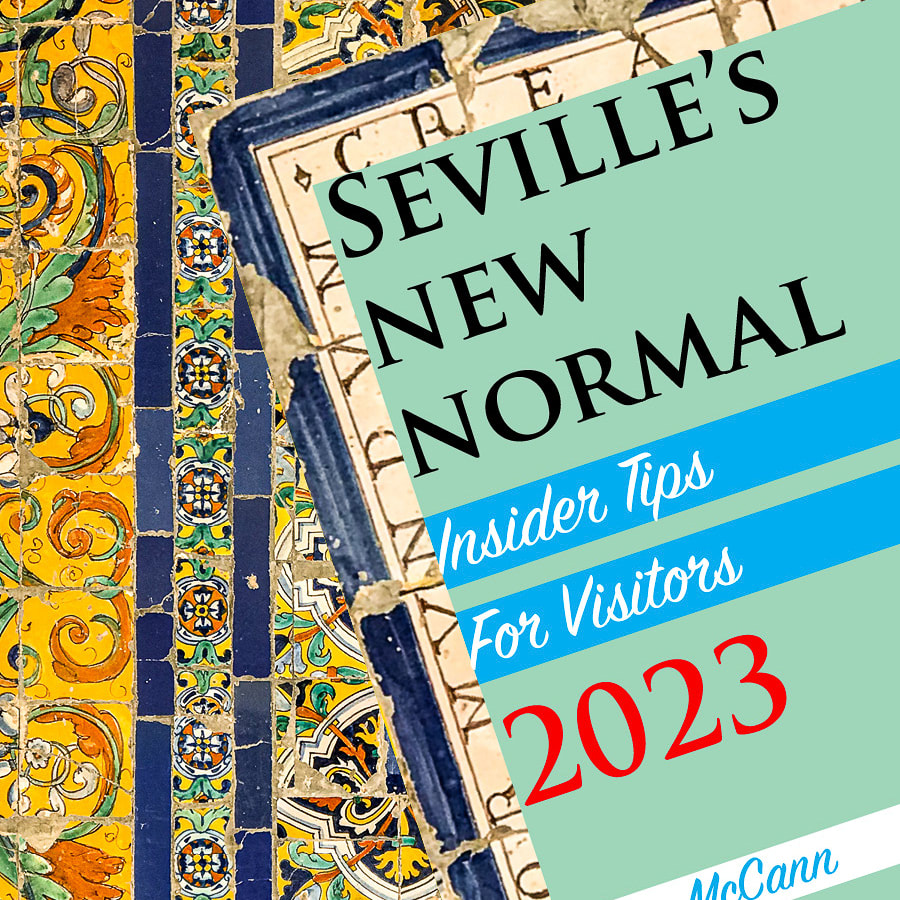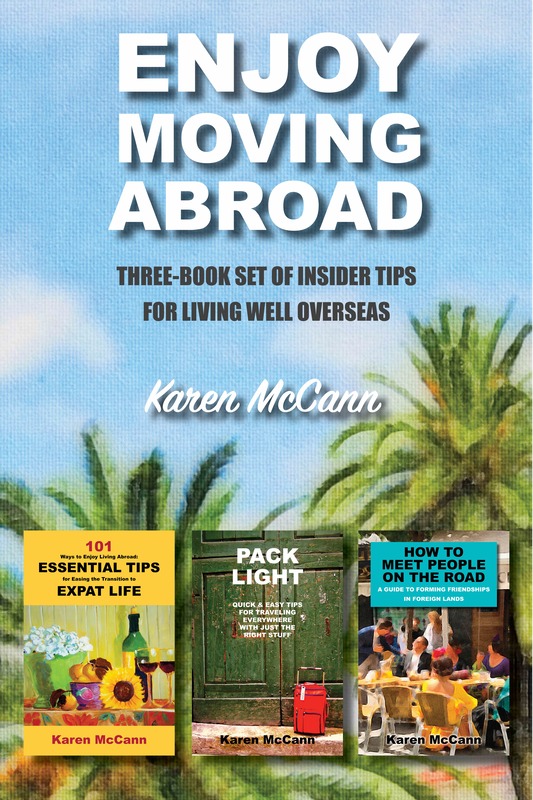|
So I’m paddling along in a canoe in the Amazon rainforest, with every sense so keenly – almost obsessively – attuned to signs of piranhas, electric eels, tarantulas, pit vipers and other local hazards that I neglect to get my hand out of the way when our boat smacks up against another, and I break a finger. Ouch!!! “What do we do?” I gasp when I can speak again. “Whatever you want,” says our guide. “We can take the motorboat to the nearest town, but that’s two days away and they don’t have much in the way of medical facilities. Or I can take you to the local shaman.” I’d met the shaman when I bought a blowgun from him; I wasn’t convinced he was the man for the job. “Or I’ve heard there’s a tree around here that has sap that hardens into a hard shell when it dries; we could try that.” Obviously that would make the best story, but still... 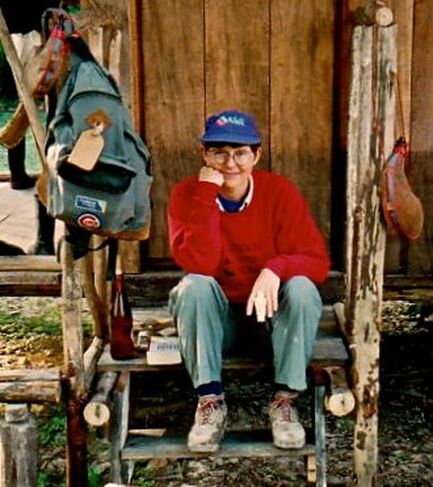 Wearing Rich's homemade splint Wearing Rich's homemade splint And then Rich says, “I have something in my first aid kit that might help...” Boy, if I had a nickel for every time I’ve heard that one. When we travel to offbeat destinations, Rich carries a vast and mysterious first aid kit that seems capable of treating anything from peevish tummies to snakebite. In the Amazon, he provided a toothache remedy to a village child, distributed moleskin patches and Itch Eraser to suffering friends, and fashioned an excellent splint for my finger out of the plastic casing that had held one of his syringes. (Yes, syringes. Luckily we’ve never needed to get an emergency injection in a village clinic that has run out of clean needles, but we’ve heard stories of people who have, and we usually carry a few with us on our more outlandish adventures, just in case.) Yesterday, Rich granted me a rare glimpse into the inner sanctum of his medical kit, currently being restocked for this summer’s train trip through Central and Eastern Europe. Here's what Rich is carrying these days: 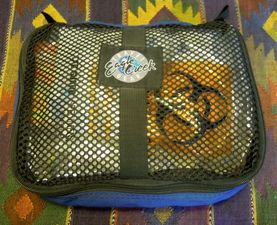 Antibiotics: Cipro, Gold Bond ointment Heat & bugs: Electrol Plus (to balance electrolytes), After Bite: The Itch Eraser, insect repellant GI woes: DigestivAid (herbal), Citrucel, Ex-lax, Imodium, Promethegan (anti-nausea suppository) Pain, fever, colds: thermometer, echinacea, paracetamol, Advil, Advil Congestion Relief Cuts, wounds, blisters: Band-Aids, Nick Relief, Compeed protective strips, butterfly closures, Omnistrips, gauze, tape Sleep aids: Quietude (homeopathic), Melatonin Hangovers: Drink Ease (homeopathic) Dental care: Poli-Grip (to secure any loose crowns) Anti-Fungal: Tinactin Allergies: Cetirizina Cinfa, Benadryl Emergency injections: syringes, biohazard bag to dispose of used syringes, alcohol swabs, latex gloves Tools: tweezers with magnifying glass, eyeglass repair kit What Rich is leaving out this time: snakebite kit, dental kit, ace bandage, moleskin (Compeed strips offer vastly superior protection from blisters) and the first aid booklet (since we now have an app for that). Some of these supplies have been around the world with us more than once. In fact, rummaging in the depths of the bag we unearthed some Tylenol that expired in 2006, Electrol Plus that lost its punch in 2007, and latex gloves that just might date back to that Amazon trip in 1993. Rich will keep updating and tweaking his collection until the eve of our departure. And I know that somewhere along the way, in Zurich or Liptovský Mikuláš or Подгорица, or maybe all three, Rich will be saying to me, “I have something in my first aid kit that might help...” This post was written in response to questions I've been asked about packing for long and varied trips. Unlike some of my better-organized and more practical blogger friends, I haven't obtained any free or discounted gear or supplies in return for promoting anything on this blog. I'm just letting you know what products and services Rich and I consider to be the most useful for our kind of travel. If you have any suggestions for things RIch should add to his first aid kit, we'd love to hear from you!
9 Comments
Have I ever told you about the miracle cure I performed on Rich? Years ago in Mexico, in a moment of misplaced confidence in the standards of our rural hotel, Rich ordered a plate of shrimp. As he popped the last glistening morsel into his mouth, he got the first inkling he was in trouble. Serious trouble. Four days later he was still in active torment, unable to keep down anything but Coca-Cola and crackers. Finally, in growing alarm, I said, “I’ve got the name of a local doctor...” At the prospect of receiving medical care in a small town in rural Mexico, Rich sat bolt upright in bed. “NO! I’m feeling a lot better.” In minutes he was dressed, within hours he was walking around, and the next day we resumed our journey. Sometimes, a good scare is the best medicine. When that’s not available, what else should you do to safeguard your health on the road? 1. Before you go, check the health advisories from the US State Department. They describe, in almost ghoulish detail, current and emerging health risks (tuberculosis on the rise in Bulgaria!), potential dangers (responding to radiological and nuclear incidents!) and which destinations have such dubious medical care that you’ll want to carry evacuation insurance (if you still want to go, after reading all those warnings). 2. Should your destination pose worrisome risks, visit a travel medicine clinic six weeks before your trip to get vaccines, medications and advice such as what to add to your first aid kit and how to dodge insidious biohazards. Back in the 90s, before a trip to Ha Tien, Vietnam, we learned that the city’s tap water wasn’t just unfit to drink, we couldn’t even shower in it without risking a loathsome ear fungus. An important safety tip! 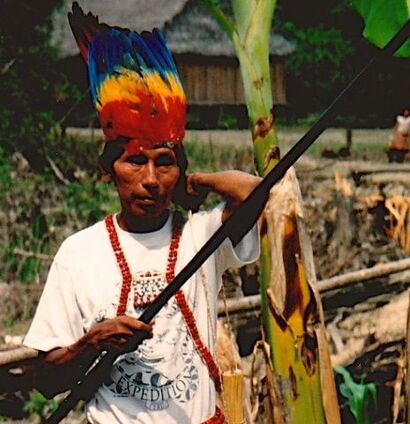 Shaman/medicine man we met in Peru Shaman/medicine man we met in Peru 3. Check your health insurance coverage. “I once had to have emergency eye surgery in Thailand,” a woman told me. “It only cost me $7 and turned out fine. So I don’t really see why I would ever need health insurance while I’m traveling.” I give her full marks for courage – and luck – but personally I wouldn't want to risk my vision on a $7 procedure. Between our US and Spanish providers, Rich and I have abundant, almost excessive coverage; when it comes to health care, we’re belt and suspender types. 4. While you’re abroad, don’t hesitate to consult local pharmacists. They’re trained health professionals and can likely provide a useful remedy and/or timely advice about finding more specialized care if needed.  Rich, at Irish spring said to cure tooth problems Rich, at Irish spring said to cure tooth problems 5. In an emergency, the EmergencyCall app instantly dials the local ambulance service and requests assistance at your location. Other buttons summon firefighters, police or a friend you designate. 6. According to the American Heart Association, which produced the First Aid app, “During the Haiti earthquake, aid worker Dan Woolley was trapped beneath the rubble with injuries on his head and leg. Luckily, he had downloaded this app, which guided him step-by-step—with reference images and videos—on how to stop bleeding and how to tie off wounds.” Best advice: try not to get into these situations! But if you must, have this lifesaver at your fingertips. Local medical care doesn’t always align with our expectations, but that doesn’t mean it won’t work. The old Spanish remedy of placing a cut onion beside the bed actually does clear your sinuses, although not as well as Sudafed. In some parts of the world, urine is said to help heal broken bones, and I expect it is effective, in its own way. The first time someone offers to pee on my broken leg, I know I’ll be sitting bolt upright in bed, saying, “NO! I’m feeling a lot better. It’s a miracle!” This post was written in response to questions I've been asked about packing for long and varied trips. Unlike some of my better-organized and more practical blogger friends, I haven't obtained any free or discounted gear or supplies in return for promoting anything on this blog. I'm just letting you know what products and services Rich and I consider to be the most useful for our kind of travel. Watch for my upcoming post on how to stock your first aid kit to handle (just about) any emergency! 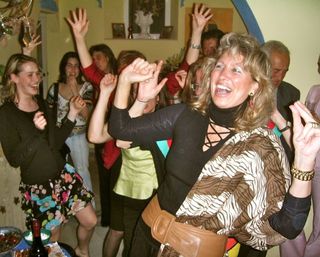 After 20 years in Ohio, following an early-to-bed, organic-vegetables-fresh-from-our-garden kind of lifestyle, adapting to Seville’s uproarious social scene was a bit of a shock. The Sevillanos consider it their God-given birthright – practically an obligation – to enjoy themselves. Even a simple tapeo (sampling of the city’s tapas bars) can run until the small hours of the morning and not infrequently includes walking home through the silent streets, arm in arm with friends, and (if I am to be totally honest with you) singing a medley of old show tunes, Beatles hits, and Besame Mucho. If I’ve learned anything from my days and nights in a city with 3000 tapas bars, it’s how to pick out a congenial place to stop for a bite and a sip. And Rich’s nose for new bars and cafés is now held in such high regard that it’s often referred to as “the Sniffer.” In our travels around the globe, we’ve found that many of the criteria we’ve honed in Seville’s tapas bars apply wherever we go. If you're wandering around an unknown city in search of a café, bar or restaurant, ask yourself: 1. Is the place crowded with locals? People in the neighborhood know where to find the best food at the best prices. If they’re standing three deep at the bar, chances are it’s worth elbowing your way in. 2. Is it noisy? When people are enjoying themselves, the buzz of convivial conversation tends to rise, and noise levels that require shouting over the din suggests that people are having a very good time indeed. It may be worth straining your vocal cords to find out what the buzz is all about. 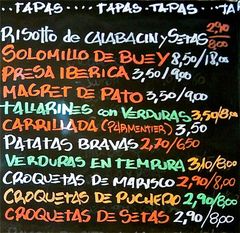 3. Is it a chain? There is a sort of alchemy to corporate ownership that transforms even the best fresh ingredients into a sort of gooey sawdust; just think about the last meal you had on a plane or in the hospital. Although there are decent franchises (I quite like the cheap shrimp and buckets of beer at Spain’s hot new chain La Sureña, for instance) in general they’re best avoided. 4. Are the menus in English? When I’m confronted with a menu written entirely in the local language, I know I’m far enough off the tourist track to find food with true regional flavor. But it can be risky. I’ll never forget the time in Japan when our friend Phil, confronted with a menu in kanji, pointed to an entry at random, and we were served a huge fish head and a fistful of chopsticks. I have now learned that the trick is to point at tasty-looking dishes that are passing by, not to incomprehensible menu items that may turn out to be fish heads, or worse. 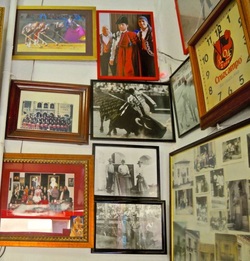 5. How is it decorated? Funky decor with a strong local flavor suggests a family owned place; with any luck, there’s a grandmother out back in the kitchen cooking with recipes revered for generations. Although I have had wonderful meals in over-manicured eateries, when I’m hunting for an authentic local dining experience, I go the funky grandmother route whenever possible. When we first moved to Seville, just about every bar and café sported dispensers of small, thin, waxy, woefully inadequate napkins; it would take a dozen or more just to get through a plate of ham. We soon learned that floors littered with greasy, crumpled napkins suggested a lively locale worthy of further investigation. Sadly, this key indicator has now faded into obscurity as proprietors have succumbed to the hot new trend of buying paper napkins with actual powers of absorption. So how do you find a good bar in Seville these days? I get that question a lot, especially during the annual spring influx of tourists, and I have decided to give it the full attention it deserves in a special page on my website. You'll find guidelines for choosing a tapas bar, photos of promising or worrisome features, and a list of Sniffer-tested favorites. If you’ll be anywhere near Seville in the near future, or simply want to know how try out new bars with Spanish-style zest wherever you may be, come visit Seville’s Tapas Bars. Cheers! I’m not saying I’m jealous, but back in August, when Rich first bought his iPad, he was holding it in his lap all day, taking it to bed every night and occasionally getting into spats with it when it exhibited annoying behavior. But I didn’t get seriously worried until he started buying it gifts. “Look what I can get for it,” he’d say, showing me yet another app he’d bookmarked for his new darling. “Here’s one that has the schedules for every train in Europe. And it’s only $2.99!” I suppose I should be grateful that they don’t sell a diamond necklace app. (And if they do, for heaven’s sake don’t tell Rich about it.) But I have to admit that Rich’s obsession with apps has paid off, as our iPad can now perform all sorts of clever tricks, such as doing currency conversions in the blink of a pixel and asking directions in 100 languages. And despite all this dazzling brainpower, we’re hardly overspending; except for iRail, which cost $2.99, all the apps on our top ten list are free. 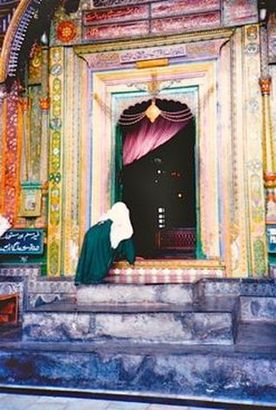 1. For all around usefulness, it’s hard to beat Triposo, an interactive guide to 8000 locations: their history, culture, festivals, places to stay, language, health and safety issues, local time and more. The travel log feature lets you share stories and photos with family and friends throughout your journey. 2. Even with Triposo, travel research is never tidy, and we always wind up with tons of bookmarked sites and snippets of information we need to corral into retrievable form, and that’s where Evernote comes in. I find it clunky to use, and the graphics have all the warmth and charm of an old Soviet bunker, but it provides a solid, utilitarian structure for assembling information into a coherent system. 3. Many of our trips start with a map taped to the kitchen wall, but our mobile choice is the map app Galileo Offline. Its built-in GPS pinpoints your location, shows where you’ve been, determines the best route to your next destination and highlights designated stopping points – cafés, ATMs, etc. – along the way. 4. For us, with our upcoming railway journey through Central and Eastern Europe, transportation is all about trains, and iRail puts European railroad timetables at our fingertips. Rich has calculated a dozen different ways to get from here to there, and (with any luck) back again. 5. We greatly prefer colorful local places to McLuxury hotels (see A Flophouse for Nightcrawlers). So we’re excited to try the app that instantly connects us with AirBnB, the hot new system of private, informal rentals, from rooms to entire houses. Even if we do wind up at a few funky places (why does the Bates Motel spring to mind?), at least we’ll have some stories to tell. 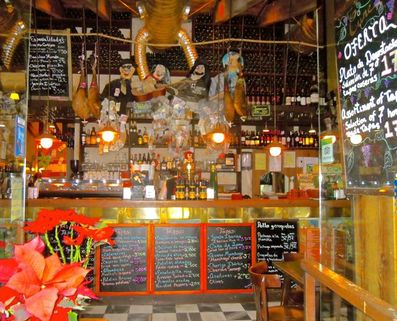 Is this a good bar? You bet. Is this a good bar? You bet. 6. Google Translate lets you type in a phrase and see the local equivalent spring onto the screen. And for places such as Bulgaria, where entering “Is this a good bar?” gives you “Дали това е добър бар,” there’s an audio button so you can listen to the correct pronunciation – if you can hear it over the chatter and clinking glasses of the place in question. The app even offers Esperanto, although I’m not sure how many Esperanto bars you’re likely to wander into. 7. If only we’d had XE Currency to check the exchange rate the last time we were in Milan, which was back before they converted to the euro. At the end of a particularly jovial evening, Rich lost track of the decimal places in the lira and left a tip larger than the bill. He was wondering why the waiters kept shaking his hand and begging him to come back soon. I’m not sure, but they may have been speaking Esperanto at the time. 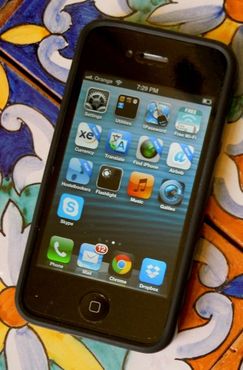 8. Free Wi-Fi Finder helps you find a nearby, no-cost place to get online. This app is far from comprehensive – it fails to list tons of places I know of in Seville, for example – but it’s a useful start. 9. You can also search out wi-fi zones using Skype Wi-Fi. If there are connection fees, it will automatically deduct them from your regular Skype account. It’s very convenient, but before you settle in for an hour-long chat with mum, be sure you know how much you’re paying; some locations, such as airports, can be pricey. 10. Track My Tour lets you update family and friends about your trip using a real-time map with photos and comments. For more see my post Was Lost But Now I’m Found ... Or Maybe Not. I prefer providing you with updates via this blog, but Rich found a security purpose for this app (yes, in addition all those detailed in last week’s post!). We’ll make daily entries on Track My Tour, and a few friends have volunteered to monitor them; if we seem to be in hot water, they’ve promised to send in the cavalry. But with any luck at all, we won’t need the cavalry, just enough connectivity to keep posting on this blog all summer. Meanwhile, if you learn of any other great travel apps, let me know! Rich and his iPad both will be celebrating birthdays this summer, and I’m looking for gift ideas. This post was written in response to questions I've been asked about packing for long and varied trips. Unlike some of my better-organized and more practical blogger friends, I haven't obtained any free or discounted gear or supplies in return for promoting anything on this blog. I'm just letting you know what products Rich and I consider to be the most useful for our kind of travel. Watch for future posts about the gear and gadgets we consider essential for civilized travel. 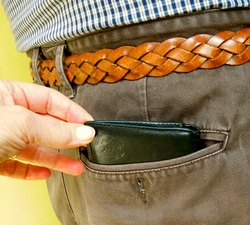 Two years ago, out of the blue, Rich announced that he wanted to become a consulting detective. I think he was kidding, but ever since then, he’s spent countless hours taking online courses in foiling pickpockets, following people, picking locks, and spotting micro-expressions and evasive techniques that reveal people are lying. Nowadays it’s nearly impossible to keep him in the dark about holiday and birthday gifts, and I clearly won’t be throwing a surprise party for him ever again. When we started planning our upcoming train trip through Central and Eastern Europe, Rich naturally took the lead in determining what security measures we’d take during our journey. I didn’t give it another thought until the other day when a package arrived, and Rich excitedly reported that it contained his RFID-blocking Rogue money clip. Say what? That’s when I asked him to sit down and tell me exactly what kinds of security measures he has in mind. Here’s Rich’s checklist of travel safety essentials. 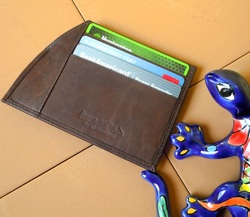 1. The RFID-blocking Rogue money clip. Apparently the microchips in many credit cards emit a radio frequency filled with your personal and financial data; tech-savvy thieves using a “skimmer” can access this data from up to 30 feet away, right through clothing, wallets, even cars. Luckily Rich has found a company that makes a money clip with credit card pockets lined with paper-thin metal sheets to block the transmission of your Radio Frequency Identification (RFID) info. I asked Rich if these were the same people who recommend putting aluminum foil on your head to block gamma rays from aliens, but he assures me this is the real deal. 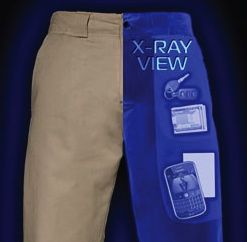 2. Scottevest 8-pocket pants with deep hidden pocket. Obviously all this RFID shielding isn’t going to do you a bit of good if someone simply filches your money clip, so Rich has purchased travel pants with a multitude of pockets and will secure his RFID-blocking money clip deep in the lower depths of an inner pocket. 3. A fake wallet. Muggers aren’t going to believe you’re not carrying any money or credit cards, and you certainly don’t want them rummaging through your pants until they find your RFID money clip in the profound inner depths. Security experts advise carrying an old wallet with a little cash and expired credit cards to hand over should the occasion arise. 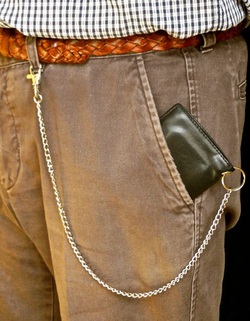 4. A chain to attach the wallet to your belt loops. Ever since he was pickpocketed by a gang of subway thieves, Rich has worn his everyday wallet on a chain clipped to a belt loop. He feels it will add verisimilitude to his fake wallet, too. Extra bonus: Buying wallets with chains already attached – most of which come embellished with the logos of heavy metal rock bands or elaborate designs involving skulls – has really boosted Rich’s street cred. 5. A hidden pouch for your passport. Rich suggests keeping your passport separately, in a hidden pouch inside your trousers, along with a bit of extra cash in case of emergencies. 6. A money belt with a copy of your passport. In case of a more comprehensive robbery, a copy of your passport will make it easier to replace at an embassy or consulate. Tuck in enough cash for taxis and a restorative drink at the nearest bar. 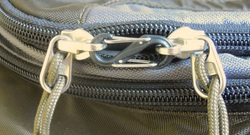 7. Zipper clips on your daypack. Anything worn out of sight on your back is vulnerable. A zipper clip discourages thieves, who won’t want to spend time fiddling and tugging in ways you’re bound to notice. 8. Cable lock to secure your suitcase on the train or in a hotel. You can’t watch your bags every second, so use a cable to attach them to a luggage rack, hotel radiator or other fixed object. 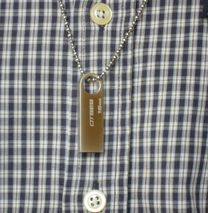 Obviously you'll wear it under the shirt. 9. A USB flash drive worn on a chain around your neck. Back up essential info – scans of passports and credit cards, phone numbers, passwords to vital online accounts, etc. – and carry it everywhere. And of course, make sure it’s password protected. 10. Trust no one (except your travel partner). Don’t assume that your hotel room or even the hotel safe will be absolutely secure. Divvy up your valuables; Rich recommends carrying some with you, hiding a few in your hotel room, putting some in the hotel safe...and then making every effort to recall just where you’ve stashed everything. I have pointed out to Rich that writing this post virtually guarantees that during our upcoming trip some enterprising robber will take this as a challenge and strip us down to our birthday suits in an attempt to retrieve valuables from all the obscure hiding places described above. But Rich points out that we never carry much cash, our credit card exposure is very limited, and our online accounts are so password protected even we have trouble getting on them. “Besides,” he points out, with that special gleam in his eye, “just think what a great case that would be for a consulting detective.” So there’s an upside to everything. This post was written in response to questions I've been asked about packing for long and varied trips. Unlike some of my better-organized and more practical blogger friends, I haven't obtained any free or discounted gear or supplies in return for promoting anything on this blog. I'm just letting you know what products Rich and I consider to be the most useful for our kind of travel. Watch for future posts about the garments, gear, gadgets and supplies that we consider travel essentials. |
This blog is a promotion-free zone.
As my regular readers know, I never get free or discounted goods or services for mentioning anything on this blog (or anywhere else). I only write about things I find interesting and/or useful. I'm an American travel writer living in California and Seville, Spain. I travel the world seeking eccentric people, quirky places, and outrageously delicious food so I can have the fun of writing about them here.
My current project is OUT TO LUNCH IN SAN FRANCISCO. Don't miss out! SIGN UP HERE to be notified when I publish new posts. Planning a trip?
Use the search box below to find out about other places I've written about. Winner of the 2023 Firebird Book Award for Travel
#1 Amazon Bestseller in Tourist Destinations, Travel Tips, Gastronomy Essays, and Senior Travel
BLOG ARCHIVES
July 2024
CATEGORIES
All
|
